The 1804 $5 Draped Bust Half Eagle: Small 8 Over Large 8 — A Rare Coin Forged in the Early Days of the U.S. Mint
Posted on — Leave a commentIn the earliest years of the United States Mint, every coin struck was more than currency — it was a piece of living history. The 1804 $5 Draped Bust Half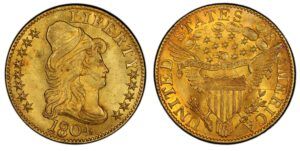 Eagle, particularly the Small 8 Over Large 8 variety, designed by Robert Scot, stands as one of the most fascinating relics of early American gold coinage. It tells a story not only of artistry and innovation but also of the enduring spirit that shaped the young nation’s economy.
Eagle, particularly the Small 8 Over Large 8 variety, designed by Robert Scot, stands as one of the most fascinating relics of early American gold coinage. It tells a story not only of artistry and innovation but also of the enduring spirit that shaped the young nation’s economy.
A Glimpse Into the Early U.S. Mint
By 1804, the U.S. Mint in Philadelphia was still mastering the art of striking gold. The Draped Bust design — featuring Liberty with soft, classical features framed by flowing hair — symbolized grace and independence. Each die was hand-engraved, meaning no two coins were exactly alike.
Gold denominations like the Half Eagle ($5 face value) were crucial for commerce and trade, bridging the gap between silver coinage and the larger Gold Eagles. During this period, gold wasn’t viewed as an investment the way it is today — it was real money in circulation, a physical embodiment of wealth and trust.
The “8 Over 8” Mystery
The Small 8 Over Large 8 variety arose from the Mint’s resourceful methods. When a die was engraved with a large “8” that proved unsatisfactory, a smaller “8” was punched over it rather than scrapping the die. This created a distinctive double-layered date — an overdate — that’s easily visible under magnification.
These imperfections tell a human story. In an age before machines controlled precision, mint workers improvised, corrected, and adapted. For numismatists, the Small 8 Over Large 8 variety offers a fascinating glimpse into 19th-century minting practices and the improvisation that produced some of America’s most rare coins.
Gold, History, and Survival
The 1804 Half Eagle is a survivor in every sense. Many early gold coins were melted down as the price of gold fluctuated or after the Coinage Act of 1834, which changed gold’s legal value and weight. As a result, only a fraction of early Pre-1933 gold coins still exist today — and the 1804 Half Eagle ranks among the rarest.
Each surviving example is a tangible connection to the birth of American finance. These coins circulated in an era before banks and credit cards, when trust in gold defined trade itself. Holding one today is like holding a page torn from history — one that gleams with the unmistakable luster of U.S. Mint craftsmanship.
A Collector’s Treasure
Owning an 1804 Small 8 Over Large 8 Draped Bust Half Eagle is more than an acquisition — it’s an achievement. Each coin represents a story of survival and skill. Collectors prize this piece for its combination of low mintage, die variety, and visual charm.
As with all Pre-1933 Gold Eagles, the appeal lies in both tangible value and historical significance. The 1804 Half Eagle reminds us of a time when coins were handcrafted, when mint workers’ hands shaped each die, and when gold itself passed through the pockets of America’s pioneers.
Why Collectors Still Pursue the Draped Bust Series
Collectors and investors alike continue to seek out Draped Bust coins for their beauty, scarcity, and deep historical resonance. Every coin tells its own story — of human craftsmanship, early mint experimentation, and the evolution of American artistry.
For those passionate about numismatics, the 1804 $5 Draped Bust Half Eagle Small 8 Over Large 8 is a cornerstone of any serious collection. Its rarity and overdate charm make it one of the most discussed rare coins in early U.S. gold series — a coin that embodies the heritage, artistry, and integrity that define the U.S. Mint’s earliest era.
Final Thoughts
In a world increasingly defined by the digital, coins like the 1804 Half Eagle remind us of something enduring — the feel of solid gold, the marks of human hands, and the stories that survive through centuries. As part of the broader legacy of Pre-1933 U.S. Mint Gold, this coin stands as a timeless symbol of both American history and enduring value.
Why a 1 Kilo Gold Bar is a Good Investment
Posted on — Leave a commentThe 1 kilo gold bar sits in the perfect middle ground for serious precious metals investors. It’s large enough to offer lower per-ounce premiums than smaller bars, yet manageable enough for individual ownership and storage. Consequently, this size has become a global standard in precious metals markets. Major refineries worldwide produce 1 kilo bars to identical weight and purity standards, though dimensions and finishes may vary slightly between cast and minted forms. This guide covers everything you need to know about 1-kilo gold bars, from exact specifications to authentication features and how they fit into a precious metals portfolio.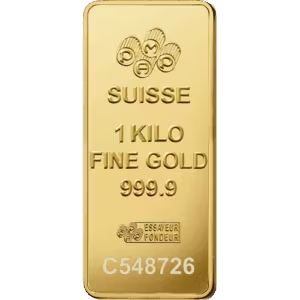
What Is a 1 Kilo Gold Bar?
The 1000-gram gold bar didn’t become the world’s preferred investment size by accident: it represents decades of market evolution toward the most practical bullion format.
The Metric Standard
The 1000-gram format emerged as the international bullion standard during the late 20th century as global precious metals markets became increasingly interconnected through improved communication technology and international banking systems. Previously, different countries used varying weight systems, such as British troy ounces, Chinese taels, Indian tolas, creating confusion when trading across borders. A bar weighed in London using troy ounces needed conversion when sold in Asia using different measurements. The metric kilogram provided a universal standard that eliminated these conversion errors and streamlined international transactions. Major trading centers could now price, weigh, and verify bars using identical measurements, reducing costs and increasing market efficiency.
Ounce Conversion for US Investors
For American investors accustomed to thinking in ounces, a 1-kilo gold bar contains exactly 32.15 troy ounces. The familiar ounce framework helps investors understand exactly what they’re purchasing without getting lost in metric conversions.
Investment Positioning
The 1-kilo bar of gold fills a crucial gap in the bullion market. It’s substantially larger than popular retail sizes like 100-gram bars or 10-ounce bars, yet far more accessible than institutional 400-ounce Good Delivery bars that typically require vault storage and minimum account balances. This positioning makes 1 kilo bars ideal for serious individual investors seeking efficiency without institutional requirements.
Global Acceptance
Major refineries worldwide, from PAMP Suisse to Perth Mint, produce 1 kilo bars because this size offers the optimal balance of production efficiency and market demand. The bars are large enough to justify the refining and certification costs while remaining small enough for individual investors to purchase and store. Banks, dealers, and investors globally recognize this standardized size, meaning you can sell a PAMP 1 kilo bar in New York just as easily as in Singapore or London.
1 Kilo Gold Bar Physical Specifications
Investment-grade gold bars are precision-manufactured products built to exacting international standards.
Exact Measurements
All 1-kilo gold bars contain exactly 1,000 grams of fine gold, but their physical dimensions vary depending on the refinery and whether the bar is cast or minted. Cast 1 kilo bars are compact and thicker, typically measuring around 80 mm × 40 mm × 18 mm (about 3.1″ × 1.6″ × 0.7″). Minted 1 kilo bars are flatter and larger in surface area, usually about 117 mm × 53 mm × 8–10 mm (about 4.6″ × 2.1″ × 0.3–0.4″). While dimensions differ slightly between PAMP, Valcambi, Perth Mint, and other refiners, both cast and minted kilo bars are designed to balance handling convenience with efficient vault storage.
Weight Precision
Investment-grade 1-kilo bars must weigh 1000.0 grams within strict tolerance limits, typically ±0.1 grams. This precision ensures accurate pricing and eliminates disputes during transactions. Similar precision standards apply across all precious metals, from silver bars of various sizes to gold bars.
Purity Requirements
The industry standard for investment-grade bars is .9999 fine gold, meaning 99.99% pure gold content. This “four nines” purity level represents the highest commercial standard available. Some refineries achieve .99999 purity, but .9999 remains the accepted benchmark for international trading. Watch this video to see how 99.99% pure gold bars are made and understand the precision manufacturing process behind these investment-grade products.
Surface Characteristics
1 kilo bar of gold bullion comes in two main finishes: cast and minted, each reflecting different production methods and cost considerations. Cast bars are poured directly into molds, creating a rougher, more industrial appearance with slight surface irregularities. This simpler process makes them less expensive to produce, so they typically carry lower premiums over spot gold prices. Minted bars undergo additional machining steps to create smooth, mirror-like surfaces with crisp edges and detailed engravings. The extra production costs result in higher premiums, but many investors prefer their polished appearance and precise details. Both types of bars meet identical purity and weight standards so investors’ choice depends on whether they prioritize lower cost or premium aesthetics.
Major 1 Kilo Gold Bullion Bar Manufacturers
While dozens of refineries produce 1-kilo gold bars, a select few have earned global recognition for exceptional quality and security features that command premium prices in international markets.
PAMP Suisse Leadership
PAMP Suisse stands as a strong market leader in premium precious metals refining, with its 1-kilo bar of gold bullion representing the gold standard for serious investors.
Background and Swiss Heritage
PAMP (Produits Artistiques Métaux Précieux) was founded in 1977 in Ticino, Switzerland, by a group of precious metals specialists who recognized the growing demand for investment-grade bullion products. The company revolutionized the industry by focusing on artistic designs and advanced security features rather than simply producing plain bars. Within a decade, PAMP had become the world’s leading brand name in precious metals, processing over 450 tons of gold annually. The company’s Swiss heritage carries significant weight in precious metals markets, as Switzerland’s centuries-old reputation for precision manufacturing and financial stability translates directly into market confidence. This reputation allows PAMP bars to command higher premiums than competitors, as investors pay extra for the Swiss quality assurance and the security that comes with Swiss financial tradition.
Fortuna Design
The Suisse 1 kilo gold bar features PAMP’s Lady Fortuna design, portraying the Roman goddess of good fortune with gently curvilinear lines that seamlessly integrate with the bar’s rectilinear borders. The design incorporates her ancient symbols of prosperity: a sheaf of wheat, the poppy flower, the Horn of Plenty, the Wheel of Fortune, and the Hands of Fortune that share her benevolence. This exceptional economy of space showcases PAMP’s artistic philosophy: that precious metals products should be beautiful works of art, not merely functional bullion.
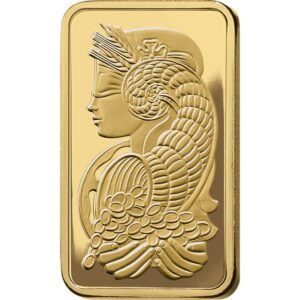
Image: PAMP Suisse Lady Fortuna 1 kilo gold bar showing the detailed Roman goddess design with wheat sheaf, horn of plenty, and intricate relief work.
Source: PAMP
Veriscan Technology
PAMP pioneered advanced anti-counterfeiting technology with its Veriscan system. Each bar features a unique digital fingerprint created during production, allowing authentication through a smartphone app. This technology provides unprecedented security and has set the industry standard for modern bullion authentication.
Production Standards
PAMP maintains LBMA Good Delivery accreditation, meeting the London Bullion Market Association’s strict standards for purity, weight, and appearance. This accreditation ensures global acceptance and liquidity for PAMP bars in any major precious metals market.
Other Recognized Refineries
While PAMP sets the premium standard, several other world-class refineries produce 1 kilo bar of gold bullion that command global respect and recognition.
Valcambi
This Swiss competitor takes a distinctly different design approach, featuring clean, modern aesthetics rather than classical imagery. Their bars often showcase geometric patterns and contemporary styling while maintaining the same Swiss quality standards that make them globally accepted.
Metalor
With traditional banking heritage dating back to 1852, Metalor brings old-world Swiss craftsmanship to modern bullion production. Their bars feature a clean, minimalist design approach that emphasizes function over decoration. The simple layout includes essential information like weight, purity, and serial numbers in straightforward typography.
Perth Mint
Founded in 1899 as a branch of Britain’s Royal Mint, the Perth Mint is Australia’s official bullion producer and one of the oldest operating mints in the Southern Hemisphere. The Mint produces 1 kilo gold bars that carry both LBMA and COMEX accreditation, ensuring international recognition. While their larger wholesale bars are plain in design, Perth’s retail-oriented kilo bars often feature their swan logo and meticulous finishing. Investors value the Perth Mint’s sovereign backing by the Government of Western Australia, which provides an additional layer of trust and security. Those seeking to buy 1 kilo gold bar products with government guarantees often choose Perth Mint for this assurance.
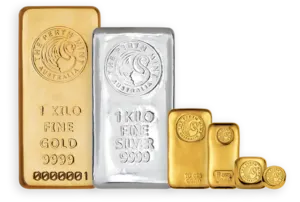
Image: Perth Mint precious metals bars showing size comparison from 1 1-kilo bar of gold and silver down to smaller fractional sizes with swan logos.
Source: Perth Mint
Royal Canadian Mint
The Royal Canadian Mint, established in 1908, is a world leader in minting innovation and security. Its 1 kilo gold bars are recognized globally for purity and precision, benefiting from RCM’s industry-leading refining capacity (able to produce gold of .99999 fineness, among the purest in the world). The bars feature advanced security features such as precision radial lines and laser-engraved micro-engraving, building on the same technology RCM applies to its Maple Leaf coins. Investors are drawn to RCM products not only for their exceptional quality but also for the sovereign guarantee of the Government of Canada.
Authentication and Security Features
Authenticating a 1-kilo gold bullion bar requires understanding the sophisticated security measures that separate genuine investment-grade products from counterfeits flooding the market.
Serial Numbers
Every legitimate 1-kilo gold bar carries a unique serial number that links directly to the refinery’s production records. These numbers vary by manufacturer – for instance, PAMP uses alphanumeric codes, while Perth Mint uses purely numeric sequences. The serial number should be deeply stamped or engraved, never just surface-etched, and match the refinery’s documented format exactly.
Assay Certificates
Genuine bars come with official assay certificates that detail weight, purity, and production information. These certificates feature security elements like watermarks, special paper, and unique identifiers that match the bar’s serial number.
Packaging Integrity
Many leading refiners seal bars in tamper-evident plastic packaging with unique security features. PAMP’s Veriscan packaging includes QR codes for smartphone verification, while other manufacturers use heat-sealed plastic with distinctive markings. Any signs of resealing or altered packaging should raise immediate red flags.

Image: PAMP Suisse Veriscan authentication system showing hands using smartphone app to verify gold bars with QR codes and security packaging.
Source: MKS Pamp
Verification Methods
Professional authentication involves precise weight measurements (genuine bars weigh 1000 g within a very tight tolerance), dimensional checks, and magnetic testing. Gold is not magnetic, so any attraction to magnets indicates fake content. Sound tests (as genuine bars produce a distinct ringing tone when struck) may provide additional verification.
Counterfeiting Concerns
Common fake indicators include incorrect fonts, misspelled text, wrong dimensions, and tungsten cores designed to mimic gold’s weight. Always purchase from reputable dealers and verify all security features before completing transactions.
Investment Considerations for 1 Kilo Gold Bars
Understanding both the advantages and limitations of 1 kilo gold bars helps investors determine whether this size fits their portfolio strategy and financial situation. For a broader context on gold’s role in investment portfolios compared to stocks, consider how precious metals provide diversification benefits.
Advantages
Lower Premiums
1-kilo bars typically carry lower premiums over spot prices compared to smaller denominations like 100-gram bars. This cost efficiency becomes increasingly significant on larger purchases, where even modest percentage differences can translate into substantial savings. When evaluating the 1-kilo 24k gold bar price, factor in these premiums over the base spot price.
Storage Efficiency
These bars maximize gold content relative to their size, making them ideal for investors with limited safe or vault space. Compared to holding the same weight in multiple smaller bars, a single 1-kilo bar is more compact, easier to transport, and often cheaper to insure.
Global Recognition
Major dealers and institutions worldwide accept 1 kilo bars from reputable refineries without hesitation. This universal acceptance ensures liquidity whether you’re selling in New York, London, or Singapore.
Considerations
Higher Entry Cost
Purchasing a 1-kilo bar requires a considerable upfront outlay, making it one of the more capital-intensive ways to invest in physical gold. This level of commitment may not be practical for every investor, and it often requires careful consideration of overall portfolio balance, liquidity needs, and long-term goals. For those building retirement portfolios, consider how gold and silver can be included in IRA accounts to maximize tax advantages.
Liquidity Timing
Accredited 1-kilo bars are globally recognized and highly liquid with professional dealers and institutions. However, in private resale markets they may take longer to move than smaller bars, since fewer individual buyers are able to purchase such a high-value piece outright.
Storage and Handling Guidelines
Proper storage and handling protect your 1-kilo gold bar value and ensure these valuable assets remain in pristine condition for future resale. For comprehensive guidance, review Blanchard’s precious metals storage guide.
Physical Handling
Always handle bars with clean cotton gloves to prevent fingerprints and oils from damaging the surface. Support the full weight when lifting and never grip by edges alone. Store bars in their original protective packaging whenever possible, as removing them unnecessarily increases scratch risk and may affect resale 1 1-kilo gold bar value.
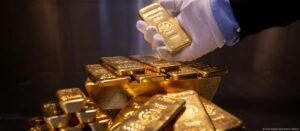
Image: Hand in white glove holding gold bar above a collection of stacked gold bars demonstrating proper handling techniques for precious metals.
Source: Deutsche Welle
Home Storage
For private storage, use a high-quality safe with a recognized burglary rating such as TL-15 or higher. The safe should be professionally installed, ideally anchored into concrete, and fire-resistant. Keep the storage location confidential and avoid drawing attention to your holdings.
Professional Storage
Depository services offer allocated or segregated storage, ensuring your specific bars remain individually identified. Leading depositories provide allocated storage with detailed documentation, insurance coverage, and regular auditing. This option eliminates home storage risks while maintaining direct ownership.

Image: Gold bars stored in a bank safe deposit box showing secure storage of precious metals with numbered compartments.
Source: Metals Edge
Insurance Planning
Standard homeowners’ insurance rarely covers precious metals adequately. Obtain separate valuable items coverage or specialized precious metals insurance. Document everything with photographs, serial numbers, and purchase receipts. Store documentation separately from the physical bars to ensure access during claims.
Conclusion
The 1-kilo gold bar represents the optimal balance between cost efficiency and accessibility for serious precious metals investors. With standardized weight, .9999 fine gold purity, and rigorous authentication features, these bars offer lower premiums and maximum storage efficiency compared to smaller denominations.
For investors seeking substantial precious metals exposure with institutional-quality products, 1 kilo gold bars deliver unmatched efficiency and professional credibility. Explore Blanchard’s selection of 1-kilo gold bars and other precious metals to build your portfolio with confidence.
FAQs
1. How much is a 1-kilo gold bar worth?
1 kilo gold bar price equals the current spot price of gold multiplied by 32.15 troy ounces. Since gold prices fluctuate daily based on market conditions, the bar’s worth changes constantly with the precious metals markets.
2. How many ounces are in a 1-kilo gold bar?
A 1-kilo gold bar contains exactly 32.15 troy ounces.
3. What are the dimensions of a 1-kilo gold bar?
A 1-kilo gold bar contains exactly 1,000 grams of fine gold, but its dimensions vary by refinery and whether it is cast or minted. Cast bars are typically more compact, around 80 mm × 40 mm × 18 mm (3.1″ × 1.6″ × 0.7″), while minted bars are flatter, about 117 mm × 53 mm × 8–10 mm (4.6″ × 2.1″ × 0.3–0.4″).
1853-O Seated Liberty Half: The Rare “Arrows and Rays” Coin Every Collector Covets
Posted on — Leave a commentIn the formative decades of the United States Mint, every coin struck carried more than face value — it carried a story. The 1853-O Seated Liberty Half Dollar, particularly the “Arrows and Rays” variety, stands as one of the most fascinating artifacts of mid-19th century American coinage. It tells a story of economic adaptation, artistic refinement, and the evolving identity of a growing nation.
coinage. It tells a story of economic adaptation, artistic refinement, and the evolving identity of a growing nation.
A Glimpse Into the Mid-19th Century Mint
By 1853, the U.S. Mint was confronting challenges brought about by shifting metal values and the growing demands of commerce. Silver coins, long a foundation of everyday trade, had begun to vanish from circulation as their melt value exceeded their face value. To preserve the use of silver in coinage, Congress passed the Coinage Act of 1853, which slightly reduced the silver content in half dollars and other denominations.
The Mint needed a clear way to signal this change to the public. The solution came in the form of small arrows beside the date on the obverse and rays radiating from the eagle on the reverse. These simple yet striking design modifications distinguished the new, lighter-weight issues from previous ones. The result was one of the most visually distinctive and historically important half dollars in U.S. coinage history.
The Role of the New Orleans Mint
The “O” mintmark tells us this coin was struck at the New Orleans Mint, one of the few branch facilities producing U.S. coinage in the antebellum South. Every die was hand-prepared, meaning no two coins were exactly identical. Subtle differences in strike, alignment, and finish give each piece its own personality — a reminder of the artistry and human effort behind every issue.
The obverse features Liberty seated on a rock, holding a shield symbolizing strength and readiness, and a staff topped with a Liberty cap representing freedom. On the reverse, an eagle spreads its wings, surrounded by sunburst-like rays and framed by arrows — a bold expression of movement and change.
The “Arrows and Rays” Distinction
The “Arrows and Rays” design was short-lived, produced only in 1853 before the Mint reverted to a simpler format. This makes the variety especially prized among collectors. The arrows and rays are not mere decoration — they represent a defining moment when the Mint openly marked a shift in the nation’s monetary standard.
Each surviving example of the 1853-O Seated Liberty Half “Arrows and Rays” tells the story of a young economy balancing artistry, practicality, and progress. It reflects how the Mint adapted to economic pressures while preserving beauty and symbolism in coinage.
Silver, History, and Survival
Many 19th-century silver coins endured heavy use in circulation, and countless others were later melted for bullion. As a result, well-preserved examples of the 1853-O “Arrows and Rays” are scarce today. Those that remain offer collectors a glimpse into America’s financial past — a tangible artifact from an era when silver coins passed through the hands of merchants, pioneers, and citizens shaping the nation’s future.
Holding one is like holding a chapter of U.S. history — a coin that survived changing laws, economic shifts, and the test of time. It is a physical reminder of when silver truly served as money, trusted and valued in every corner of the young republic.
A Collector’s Treasure
Owning a 1853-O Seated Liberty Half “Arrows and Rays” is more than a milestone in numismatics — it is an achievement. Collectors prize this coin for its one-year-only design, low mintage, and powerful symbolism. It represents the intersection of artistry and adaptation, where every design element served a purpose and every coin told a story of national growth.
For many enthusiasts, the “Arrows and Rays” variety stands among the most iconic issues of the Seated Liberty series. It bridges two eras — the early Mint’s handcrafted tradition and the increasingly industrialized coinage of the later 19th century.
Why Collectors Still Pursue the Arrows and Rays Series
Collectors continue to pursue the 1853-O “Arrows and Rays” Half Dollar for its rarity, beauty, and historical resonance. It represents an era of transformation within the U.S. Mint, when even small design changes carried deep economic and cultural meaning. Each coin is a testament to craftsmanship, resilience, and the evolving relationship between money and trust in a growing nation.
Final Thoughts
In an age when currency is digital and intangible, coins like the 1853-O Seated Liberty Half “Arrows and Rays” remind us of something enduring — the weight of real silver, the marks of human hands, and the stories engraved in metal that have outlasted generations. As part of the broader legacy of U.S. Mint silver coinage, this piece stands as a timeless symbol of innovation, adaptation, and the artistry that defines America’s numismatic heritage.
Gold Breaks $4,000 Oz.: Why 2025’s Run Matters
Posted on — Leave a commentAt long last, gold has done it: it crossed the $4,000 per oz. threshold today, something no one had ever seen before. While intraday trading pared some gains, the climb to that round number signals deeper tectonic shifts in how investors are viewing risk, monetary policy, and macro stability. In this post, we dive into gold’s enduring role, the reasons behind its meteoric ~51% advance in 2025, and what this may hint at going forward.
gains, the climb to that round number signals deeper tectonic shifts in how investors are viewing risk, monetary policy, and macro stability. In this post, we dive into gold’s enduring role, the reasons behind its meteoric ~51% advance in 2025, and what this may hint at going forward.
The Classic Role of Gold
Gold has always been more than a precious metal. Over centuries, it’s occupied a place in financial portfolios as a hedge, a reserve asset, and a refuge when faith in paper currencies wobbles. In modern times, its key functions are:
- Inflation hedge: When money loses value, gold often retains purchasing power better than cash.
- Safe haven: At times of crisis or market stress, gold becomes a go-to as investors flee risk assets.
- Portfolio diversifier: During turbulence, it often exhibits weak correlation with stocks or bonds.
- Reserve backing: Central banks hold gold—not for yield, but as structural financial insurance.
So when a price that once seemed far-fetched becomes real, it reinforces gold’s standing in the minds of institutional and retail players alike.
What Powered Gold’s 50%+ Climb in 2025
Moving 50% within a year—especially for a non-yielding asset—is unusual. But for gold, several strong tailwinds have come together:
- Central bank accumulation: Non-U.S. central banks, seeking to diversify reserves, have been persistent buyers. Their demand is less price-sensitive, giving gold a structural backbone.
- ETF & institutional demand: As gold gained momentum, funds and institutions poured capital into physically backed vehicles, reinforcing the rally.
- Dollar dynamics: A softer U.S. dollar makes gold cheaper in foreign currency terms, broadening demand globally.
- Rate-cut expectations & low real yields: As markets increasingly price in sharp Fed cuts (some metrics show >80% odds), gold’s opportunity cost declines.
- Macro, political, and policy risk: The U.S. government shutdown, volatile trade policy, global power shifts, and signs of weakness in labor markets all feed safe-haven flows.
- Momentum & market psychology: Once gold broke key thresholds—above $3,000, $3,500, $3,800—momentum traders piled in, creating a self-reinforcing ascent.
The Significance of the $4,000 Break
Surpassing $4,000 is more than a headline. It reshapes narrative and expectations. Here’s what it signals:
- Repricing risk assets: When gold’s bid feels intense, markets may be anticipating more downside or weaker growth ahead.
- Fed constraints & credibility risks: Gold’s rally assumes easier monetary policy ahead. If inflation surprises or the Fed holds hawkish, the trade could reverse sharply.
- Volatility risk: Big moves often bring big corrections. Positioning risk is elevated.
- Portfolio rebalancing: Institutions and HNW investors may revisit gold allocations now that a new regime appears in play.
Despite the risks, many analysts remain bullish. Goldman Sachs, for instance, recently lifted its December 2026 gold target to $4,900 an oz.
Final Thoughts & What to Watch
Gold’s surge past $4,000 is at once dramatic and unsurprising—dramatic because it’s historic, unsurprising because the underlying forces are well known to markets. But as with all extremes, this moment is a pivot, not an endpoint.
In the weeks ahead, watch closely:
- Fed commentary & policy surprises — if the central bank resists easing, gold could correct sharply.
- Inflation data & real yields — unexpected inflation strength could raise real yields and undercut gold’s appeal.
- Central bank buying pace — any slowdown could remove the structural bid.
- Flows into/out of gold funds — large redemptions or swings in sentiment may trigger volatility.
- Macro or political shocks — any new risk event may reignite safe-haven flows (or reverse direction if confidence returns).
Take Action
True ownership means having real metal in your hands, not promises on paper. Because when you hold it, you don’t just own it, you possess it. Which one do you want?
Is The Stock Market Overvalued? Yes. Here’s How You Can Prepare
Posted on — Leave a commentThere’s all sorts of market sayings that investors turn to when they want to ignore facts. “This time it’s different” or “This is the new normal.” But, here’s another saying to consider: “Be fearful when others are greedy and greedy when others are fearful.”
The U.S. stock market has bounced back from its early year decline and is posting gains of about 13% since January. The S&P 500 has touched a new record high, but valuations are high—very high. The 12-month forward price-to-earnings ratio for the S&P 500 stands at 26—that’s bubble territory, and far above the 20-year average of 16.
For some, today’s AI-driven euphoria on Wall Street is reminiscent of the dot.com market boom and bust in 2000-2002.
Looking Back: A 78% Stock Market Crash
The dot.com U.S. stock market bubble peaked in March 2000. From there, the NASDAQ composite index saw tech stocks fall 78% into the October 2002 low. Now that 78% decline is a scary number, but here’s another sobering statistic. It took 15 years for the NASDAQ to recover to its peak value before the crash. Do you have 15 years to wait before you get 3/4 of your portfolio back?
What Does the Buffett Indicator Say Now?
Here’s another stock market measure to consider. Warren Buffett offered a simple guide to measure the state of the U.S. stock market. Known today as the Buffett Indicator, it measures the total U.S. stock market capitalization against the country’s GDP. Buffett once said: “If that percentage relationship falls to the 70% or 80% area, buying stocks is likely to work very well for you. If that approaches 200% as it did in 1999 and part of 2000—you are playing with fire.”
Where’s the Buffett Indicator today? A whopping 213%–well above dot.com levels.
Do You Want To Play Defense and Protect Your Money?
If you are wondering if this is a bubble, the sad truth is that we only know after the fact—after the bubble has popped. Market history does show that bubbles or periods of extreme stock market overvaluation are followed by sharp declines or a crash.
For investors the message is clear. A well-diversified portfolio remains one of the best defenses for an investor and can provide protection against sudden stock price downturns—when it can be difficult to get out of the market. If you are concerned that you might be overexposed to risky assets like stocks, here are a defensive game plan to consider.
Legendary Investors Are Selling Stocks, Buying Precious Metals
Multimillionaire investor and Wall Street legend Jim Roger recently sold all his U.S. stocks, warning “he’s seen this party before.” Roger’s estimated net worth stands at about $300 million and he retired at the age of 37 after astounding success in the fund he co-founded, the Quantum Fund, which generated growth of over 4,200% in its first decade.
When Rogers recently shared that he had sold his U.S. stocks, he also revealed where he is turning to for wealth preservation: precious metals. “I own a lot of gold and silver,” Rogers said.
Other billionaire investors are sharing the same advice. Ray Dalio, founder of the largest hedge fund in the world, Bridgewater Associations told CNBC that people “don’t have, typically an adequate amount of gold in their portfolio.”
“When bad times come, gold is a very effective diversifier,” Dalio explained.
Increase Your Allocation to Precious Metals Now
If you are concerned about the potential for a stock market drop, consider selling a portion of your allocation to stocks. If you take a look, your stock allocations could be stretched and you could be taking on more risk that you even realize.
Invest those proceeds into gold and silver. Physical precious metals are the best performing asset class of 2025 and they are still climbing. Here’s another old Wall Street saying to consider: “Stocks take the stairs up, and the escalator down.” The best time to play defense and buy more wealth protection with gold and silver is before the stock market begins its downward spiral.
The best time to play defense is today.
Everything You Need to Know About the Perth Mint: Coins, Bars, and Investment Insights
Posted on — Leave a commentThe Perth Mint refines more gold annually than many countries produce, yet many investors overlook this 125-year-old powerhouse. Established during Australia’s gold rush, the Western Australian institution has since become a globally recognized leader in bullion. With government backing, rigorous authentication standards, and exceptional quality control, its gold bars, silver coins, and bullion products stand apart. This article explores Perth Mint’s role in global precious metals markets and why its products are essential to sophisticated investment portfolios.
What Is the Perth Mint?
Perth Mint is one of the world’s most significant precious metals institutions, combining government ownership, vast refining capacity, and a dual role as both a refinery and sovereign mint. For a video tour of the Mint’s original facility, click here.
Historical Foundation
The Perth Mint opened its doors in 1899 as a branch of Britain’s Royal Mint, established specifically to process the flood of gold pouring from Western Australia’s Kalgoorlie goldfields. The Western Australian gold rush had transformed the region into one of the world’s most productive gold mining areas, creating an urgent need for local refining capacity. During its first decade alone, the mint processed over 106 million ounces of gold, i.e. more than some modern countries mine in multiple years.
Government Backing Since 1970
In 1970, the Western Australian government purchased the Perth Mint from the British government as part of Australia’s transition away from the gold standard. This ownership change transformed how the mint operated: instead of being just another commercial refinery, it became a government-backed institution where the state guarantees every product’s weight, purity, and authenticity. The difference is significant: while private mints rely on their reputation and insurance policies, Perth Mint products carry the full backing of the Western Australian government.
Global Refining Powerhouse
Today’s Perth Mint processes over 300 tonnes of gold annually, roughly equivalent to the entire annual gold production of Ghana or Peru. The Mint’s LBMA-accredited refinery doesn’t just handle Australian gold; it processes precious metals from across the Asia-Pacific region, making it a central hub in global supply chains. The facility produces everything from 1-ounce retail bars to 400-ounce Good Delivery bars meeting London bullion market standards.
Dual Operations Model
The Perth Mint operates as both a commercial refinery and a sovereign mint, a combination that’s virtually unique. Its refinery side processes raw gold and silver for mining companies, banks, and other commercial clients. Simultaneously, the mint division produces legal tender coins for collectors and investors, including the famous Australian Kangaroo and the Perth Mint Lunar series that command premium prices worldwide.
Perth Mint Location and Facilities
The Perth Mint encompasses both its historic 1899 headquarters in central Perth and a modern refinery complex that ranks among the world’s leading precious metals facilities.
Geographic Position
The Perth Mint is located in Perth, Western Australia. This geographic position provides significant advantages for accessing Asia’s rapidly growing precious metals markets, as Perth’s time zone aligns with key Asian financial hubs including Singapore, Hong Kong, and Tokyo. While traditional bullion centers like London operate during European hours, Perth allows Asian mining companies and dealers to conduct business during their normal working hours, making it a natural refining partner for the region’s gold producers.
Original Building
The historic 1899 mint building still stands in Perth’s city center as a heritage-listed landmark. While no longer used for commercial production, this sandstone structure now operates as a popular tourist attraction and museum. Visitors can witness live gold pouring demonstrations and view historical displays showing how the original facility processed Western Australia’s gold rush discoveries.
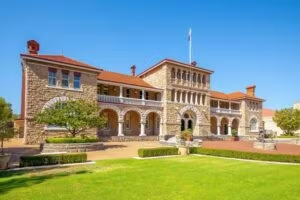 Image: The historic 1899 Perth Mint building in Perth, Western Australia.
Image: The historic 1899 Perth Mint building in Perth, Western Australia.
Source: Thrillophilia
Modern Facilities
Today’s commercial operations take place at a purpose-built industrial complex in Perth’s suburbs. This state-of-the-art facility houses sophisticated refining equipment capable of processing raw precious metals from mining operations into finished investment products. The complex operates multiple production lines that can simultaneously refine raw materials and mint coins or cast bars for retail and institutional customers.
Refining Capacity
The Perth Mint’s refinery meets some of the world’s most stringent precious metals standards. The facility holds London Bullion Market Association (LBMA) accreditation, which allows it to produce Good Delivery gold and silver bars that trade directly on international markets without additional verification. To earn this status, the Perth Mint must produce 400-ounce gold bars and 1,000-ounce silver bars that meet strict purity and quality requirements, with fewer than 80 refineries worldwide earning this prestigious designation.
Perth Mint Gold Products and Specifications
The Perth Mint offers a wide range of gold products, from investment-grade bars to collectible legal-tender coins. All carry the same guarantee of weight and purity from the Government of Western Australia, ensuring global recognition and trust. View Blanchard’s Perth Mint gold collection for available options.
Perth Mint Gold Bars: A trusted choice for investors at every level
Perth Mint gold bars are produced to the highest global standards, each containing 99.99% pure gold. They are widely accepted on international markets thanks to their recognized quality and government guarantee.
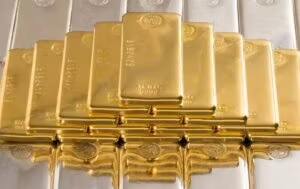 Image: A stack of gold bars, and the distinctive swan logo from the Perth Mint.
Image: A stack of gold bars, and the distinctive swan logo from the Perth Mint.
Source: Jeweller Magazine
Range of sizes
Popular sizes include the Perth Mint 1 oz gold bar and 10 oz bars for retail investors, 1 kg bars for more substantial holdings, and 400 oz Good Delivery bars for institutional use. Smaller minted bars (5g, 10g, 20g, etc.) are also available, offering flexibility for different budgets.
Security and certification
Most bars feature unique serial numbers, tamper-evident packaging, and official assay certification, while larger cast bars can be verified through the Mint’s online database. The Perth Mint logo and stamped purity marks provide additional reassurance of authenticity.
Perth Mint Gold Coins: Bullion coins with global recognition
The Mint’s coin division serves both bullion investors and collectors, producing a variety of series that combine precious metal content with artistic design. While Perth Mint issues a number of gold coins, the following are its best-known and most widely traded programs.
Australian Kangaroo series
The Kangaroo is Perth Mint’s flagship bullion coin, released annually with a new kangaroo design. This series appeals to both investors, who value its 99.99% pure gold content and international recognition, and collectors, who appreciate the evolving artwork. Its blend of reliability and variety has made it one of the most traded gold coins worldwide.
 Image: Two Perth Mint Australian Kangaroo gold coins from 2022 showing the same kangaroo and joey design.
Image: Two Perth Mint Australian Kangaroo gold coins from 2022 showing the same kangaroo and joey design.
Source: Canadian Coin News
Perth Mint Lunar series in gold
The Perth Mint Lunar Series follows the Chinese zodiac, with each year featuring a different animal symbol. Struck in limited quantities, these coins often command premiums above their gold value, as demand extends beyond investors to collectors seeking complete sets. The Perth Mint Lunar Series has built a strong global following and is regarded as one of the Mint’s most successful collectible programs.
Commemorative issues
In addition to its flagship bullion ranges, the Mint periodically releases commemorative coins highlighting Australian history, culture, and national milestones. These coins are usually produced in smaller numbers, which enhances their appeal to collectors, while still offering the intrinsic security of government-guaranteed, 99.99% pure gold.
Perth Mint Silver Products
Perth Mint’s silver range complements its gold offerings, giving investors and collectors access to high-purity bullion backed by the Government of Western Australia. The Mint produces both silver bars for straightforward investment and silver coins that combine bullion value with design appeal, each meeting strict international standards. Browse Blanchard’s Perth Mint silver collection for available products.
Silver Bars: Trusted investment bullion
All Perth Mint silver bars are refined to at least 99.9% purity, with many newer bullion coins struck in 99.99% fine silver, among the highest global standards. This consistency, combined with LBMA accreditation, ensures their ready acceptance across international markets.
Sizes and formats
The most widely traded sizes are 1 oz, 10 oz, and 1 kg, covering the needs of both new entrants and larger-scale investors. Smaller minted bars and larger cast bars are also produced, giving buyers a broad choice of entry points.
Security and authenticity
Bars carry the Perth Mint logo, weight, and purity stamp. Many are sold in tamper-evident packaging, while larger cast bars may also include serial numbers or certificates for added traceability. This makes them both practical for storage and reliable in resale markets.
Perth Mint Silver Coins: A wide-ranging bullion program
Perth Mint silver coins are well established in global markets, offering both high-volume bullion issues and collectible series with limited mintages. All are struck in 99.9% fine silver and carry legal tender status under Australian law.
Australian Kangaroo
Introduced in 2016, the silver Kangaroo is the Mint’s core bullion coin. Struck in large numbers with a consistent kangaroo motif, it competes directly with international bullion staples such as the American Silver Eagle and Canadian Maple Leaf.
Australian Kookaburra
Launched in 1990, the Kookaburra is Perth Mint’s longest-running silver bullion coin. Its annually changing designs of Australia’s iconic bird combine bullion value with strong collector interest, giving each year’s issue unique appeal.
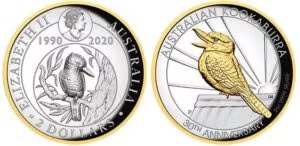 Image: The obverse and reverse of the Perth Mint’s 30th Anniversary Australian Kookaburra silver proof coin, featuring selective gold gilding on the kookaburra design and Queen Elizabeth II portrait.
Image: The obverse and reverse of the Perth Mint’s 30th Anniversary Australian Kookaburra silver proof coin, featuring selective gold gilding on the kookaburra design and Queen Elizabeth II portrait.
Source: Numismatic News
Australian Koala
Issued annually since 2007, the Koala series also features changing designs. While less widely traded than the Kangaroo or Kookaburra, it retains a loyal collector base.
Perth Mint Lunar Series in silver
Following the Chinese zodiac, the Lunar coins are produced in various sizes and finishes with limited mintages. Their popularity among collectors often results in premiums above spot value, particularly for complete sets.
 Image: Two Perth Mint bullion bars featuring the Year of the Snake design from the lunar series, one in gold and one in silver.
Image: Two Perth Mint bullion bars featuring the Year of the Snake design from the lunar series, one in gold and one in silver.
Source: The Perth Mint
Commemorative releases
Alongside its flagship programs, the Mint produces special coins marking cultural events and national milestones. These limited editions, sometimes with proof or colorized finishes, appeal mainly to collectors while maintaining guaranteed silver content.
Perth Mint Investment: Pros and Cons
Weighing both the strengths and limitations of Perth Mint bullion helps investors decide how these products fit into a diversified precious metals portfolio. Understanding the broader benefits of precious metals investing provides context for evaluating Perth Mint’s specific advantages.
Advantages
Government backing
The Western Australian government’s sovereign guarantee covers weight, purity, and authenticity, a level of security that private mints cannot match through insurance alone. This means investors have government recourse if authenticity issues arise, rather than relying solely on corporate warranties that carry counterparty risk if a private mint ceases operations.
Global recognition
Perth Mint’s 125-year history and LBMA accreditation ensure its products trade easily in major precious metals markets from London to Singapore. Dealers worldwide recognize Perth Mint hallmarks, reducing the need for additional verification when selling and potentially improving resale liquidity compared to lesser-known refiners.
Asian market access
Perth’s strategic location makes it the preferred refinery for Asian mining companies, supporting liquidity in rapidly expanding Asian precious metals markets. As Asian economies continue expanding their precious metals demand, Perth Mint products may enjoy preferential recognition in these high-growth regions. Understanding the cultural significance of gold in Asian markets helps explain why Perth Mint’s regional positioning offers long-term advantages.
Considerations
Higher premiums
The Perth Mint gold price for bars typically carries 3-5% premiums over spot gold prices, compared to 1-2% for generic rounds, due to their government backing and brand recognition. While this increases upfront costs, established brand recognition often allows these premiums to be recovered upon resale.
Perth Mint Certificates and Storage Programs
The Perth Mint operates Australia’s only government-guaranteed precious metals storage program. While the Mint’s Certificate Program (PMCP) is now limited to Australian residents, other storage services through the Depository remain available to investors worldwide.
Certificate program
The Perth Mint Certificate Program (PMCP) offers unallocated storage, allowing investors to own precious metals without physical possession, backed by the Western Australian government guarantee. Investors purchase certificates representing gold or silver held in Perth Mint’s vaults, with the government standing behind the metal’s existence and quality. Minimum investments start at AUD $1,000, and investors can buy or sell portions of their holdings at any time during business hours.
Allocated storage
For investors preferring specific bars or coins, Perth Mint offers allocated storage where particular numbered products are segregated and identified to individual owners. This service typically requires larger minimum holdings and higher storage fees but provides the security of owning identifiable physical pieces rather than claims on pooled metal.
Insurance coverage
Unlike private storage facilities that depend on commercial insurance, Perth Mint’s state guarantee reduces counterparty risk by ensuring both the existence and authenticity of stored metals. This is a level of protection that private insurers cannot match.
Liquidity features
Certificate holders can sell directly back to the Perth Mint at published buyback rates, typically 1–2% below spot for gold and 2–3% for silver. The program also allows investors to convert certificates to physical delivery, though international shipping restrictions apply to overseas customers.
Conclusion
With 125 years of history, the backing of the Western Australian government, and LBMA accreditation, the Perth Mint holds a distinctive place in global precious metals markets. As Asian economies continue to expand their demand for bullion, the Mint’s strategic location and long-standing ties with regional mining operations reinforce its role as a key player in the future of precious metals. For investors, Perth Mint products combine government-backed assurance with worldwide recognition, offering a level of security that few competitors can equal.
Ready to add Perth Mint products to your precious metals portfolio? Explore Blanchard’s comprehensive Perth Mint collection and discover other investment-grade precious metals options available for purchase.
FAQs
1. Where is the Perth Mint located?
The Perth Mint is located in Perth, Western Australia.
2. When was the Perth mint established?
The Perth Mint was established in 1899 as a branch of Britain’s Royal Mint during Australia’s gold rush. It transitioned to Western Australian government ownership in 1970 and has operated continuously for over 125 years.
3. Is Perth Mint gold good?
Yes, Perth Mint gold products are considered among the highest quality available. All gold bars contain 99.99% pure gold, exceeding most international standards. The Western Australian government guarantee and LBMA accreditation ensure global recognition and acceptance by dealers worldwide.
4. How to spot fake Perth Mint gold bars?
Check for consistent stamping quality and verify serial numbers online. Authentic gold bars feature the official Perth Mint logo, precise weight and purity markings, and unique serial numbers that can be verified through the mint’s online database. Genuine bars come with tamper-evident packaging and official assay certificates.
5. How much is a 1 oz Perth Mint gold bar worth?
The Perth Mint 1 oz gold bar trades at current gold spot prices plus a premium for the government guarantee and brand recognition.
Your First Gold Purchase: Tips, Types, and How to Get Started
Posted on — Leave a commentAre you thinking about adding gold to your financial journey but are not sure where to begin? Maybe you’ve seen headlines about rising gold prices, or perhaps a family member passed down a coin or two that sparked your curiosity. For many, gold represents both security and opportunity, yet the idea of buying it can feel overwhelming. The truth is, getting started with gold doesn’t have to be complicated. This guide will break down the basics, explain your options, and help you avoid common mistakes along the way.
Why People Buy Gold
Gold has been treasured for thousands of years for a reason. It is durable, scarce, and has value that spans cultures and generations. People buy gold for many reasons:
-
Wealth preservation: Gold holds its value and often rises during times of economic uncertainty.
-
Portfolio diversification: Owning gold can balance investments in stocks, bonds, and real estate.
-
Collecting and enjoyment: Some buyers love the history and beauty of gold coins and bars.
Whether you are investing or collecting, gold is a timeless asset that can be as exciting as it is valuable.
Types of Gold You Can Buy
When it comes to buying gold, there are several types to consider. Each has its own charm and purpose:
-
Gold Coins
Gold coins are popular because they are easy to buy, sell, and store. Examples include: -
Gold Bars
Gold bars offer a pure and straightforward way to own gold. They come in sizes ranging from 1 gram to 1 kilogram or more. Bars are ideal for serious investors who want bulk gold at competitive prices. -
Fractional Gold
If you are starting small, fractional gold coins or bars can be a great way to get your feet wet. These are smaller portions of a full ounce, perfect for beginner collectors or investors with limited funds. -
Numismatic Gold
These coins are prized not only for gold content but also for rarity, history, and condition. Examples include old Liberty Head $20 coins or Saint-Gaudens coins. Keep in mind that numismatic coins often require more research and a bit of luck to find a great deal.
What to Know Before You Buy
Buying gold can be straightforward if you know a few important details:
-
Fineness: Gold is measured in karats or fineness. 24-karat gold is .9999 fine. 22-karat gold is .999 fine. The Canadian Mint Gold Maple Leaf is .9999 fine and the Gold American Eagle is .999 fine.
-
Weight: Gold is typically measured in troy ounces. One troy ounce is 31.1035 grams. Make sure you know the size of the coin or bar before you buy.
-
Certification: For coins, certification from a professional grading service like CACG, PCGS, or NGC guarantees authenticity and grade. This can be very important for collectible coins.
-
Pricing: Gold prices fluctuate daily. Dealers charge a premium above the spot price for coins and bars. Premiums vary based on rarity, demand, and type of gold.
Buying Gold Online or With a Blanchard Portfolio Manager
At Blanchard, we make it easy for you to buy gold in the way that fits your style. Some people prefer the speed and independence of using our website, while others enjoy the guidance of a dedicated portfolio manager. Both approaches connect you with authentic, carefully sourced gold — it just depends on how hands-on you want to be.
- Using Our Website
Many new buyers love the convenience of browsing Blanchard’s online inventory. Our site offers detailed product descriptions, real-time pricing, and secure checkout so you can shop confidently from the comfort of home. Whether you are looking for American Gold Eagles, historic pre-1933 U.S. gold coins, or simple bullion bars, you can explore at your own pace and build your collection on your terms. - Speaking With a Portfolio Manager
If you prefer a more personal touch, our portfolio managers are only a phone call away. They take the time to understand your goals, whether that means creating a strategy for wealth preservation or simply starting small with a few coins. Portfolio managers also help answer questions about rarity and certification and provide insights into how gold can fit into your broader financial picture.
The best part? You do not have to choose one or the other. Many clients use the website for convenience while also leaning on a portfolio manager for strategy, big-picture planning, and market insights.
Storing Your Gold Safely
Once you buy gold, keeping it safe is essential. You have a few options:
-
Home storage: A high-quality safe is a good start. Keep your safe in a discreet location.
-
Bank safety deposit boxes: Convenient but may have access limitations.
Tips for New Gold Buyers
-
Start small. You do not have to buy a kilo of gold on your first try.
-
Learn the lingo. Terms like bullion, premium, karat, and spot price will become second nature.
-
Research dealers. Reputation matters, so stick with trusted sources like Blanchard.
-
Avoid get-rich-quick schemes. Gold grows wealth slowly over time.
-
Enjoy the process. Buying gold can be as fun as it is smart.
Final Thoughts
Buying gold is not just about investing. It is about holding a piece of history, securing your wealth, and enjoying the beauty of one of the world’s most coveted metals. By understanding the basics, starting small, and choosing trusted dealers, anyone can confidently enter the world of gold.
Gold is more than a shiny metal. It is a gateway to history, wealth, and sometimes even a little sparkle in your day. If you’re ready to begin, call 1-800-880-4653 today to speak with a Blanchard Portfolio Manager who can help you choose the right gold for your goals. Start your gold journey and discover why collectors and investors alike have treasured it for centuries.
Silver Near $45 for First Time in 14 Years Amid Strong Economic Data
Posted on — Leave a commentSpot silver soared above $46.00, recently touching the $45 an ounce level in late September. The powerful and enduring rally in precious metals this year has lifted silver as much as 55% in 2025, outpacing the 43% gain in gold. The push to fresh highs in silver comes alongside news that the U.S. economy grew at a faster pace in the second quarter.
The third estimate of Q2 U.S. GDP came in at 3.8%, which is higher than the previous estimate of 3.3%. Upward revisions to consumer spending contributed to the better number. This followed a negative reading in the first quarter of the year, which revealed that economic growth shrank by 0.6%.
Other economic news also surprised on the upside, including a 2.9% jump in August durable goods orders. Following two months of declines, big orders for military and civilian aircraft lifted the report. Military aircraft and parts saw a 50% surge in orders in August, the Commerce Department said.
Americans Still Struggle To Buy A Home
On the home front, however, fresh data reveals that Americans who want to buy a home are still struggling. In August, home sales slipped in August by 0.2%, due in large part to high home prices and elevated mortgage rates. The median home price jumped to $422,600, which is a 2% increase from a year ago and the highest price ever recorded for the month of August. Mortgage rates fell slightly recently, but 30-year mortgage rates are still considered high, at around 6.26%.
Precious Metals Stand Out As Best Performing Asset Class in 2025
Precious metals remain the favored asset for investors as economic news remains mixed. While some new data reveal growth, inflation remains higher than the Federal Reserve’s 2% target, and everyday Americans remain challenged by high interest rates.
The precious metals markets stand out as the best performing asset class in 2025. Gold has set dozens of new record highs this year. A 10% decline in the U.S. dollar, active central bank gold buying, and ongoing geopolitical tensions and wars are supporting the upward trend in gold.
Gold is on pace for its best performance in 46 years. It’s notable that gold is performing so well, even while stocks have climbed moderately this year—but the stock market is rising in part due to monetary debasement—the U.S. dollar is down 10% this year, the Fed cut rates recently, and the U.S. money supply is rising again.
Silver is climbing with support from its dual demand stream. Silver is both a precious and widely used industrial metal. Investors have piled into silver amid a risk-off mood in the stock market
and a desire to diversify into a metal that both protects against stock market volatility and also benefits from increased industrial and manufacturing uses.
Investors On the Sidelines May Be Missing Out
Analysts say the rally in precious metals has further to go. Near term, silver sees a target at $50 an ounce, and gold’s next objective is $4,000. As investors on the sidelines have experienced this year, it’s costly to underestimate the historic and powerful precious metals rally we are seeing now. Don’t wait to get involved. Consider increasing your allocation to the safety and growth that precious metals provide. There’s more upside ahead.
How Gold Supercharges Portfolio Diversification (And How Much You Should Own)
Posted on — Leave a commentFor thousands of years, gold has been a treasured asset. Gold is not only a time-honored symbol of wealth, it is a reliable store of value and wealth building tool. Today, this ancient currency’s role in modern portfolios is becoming more important than ever. As you know, global uncertainty and shifting economic tides have put gold back in the spotlight—as the precious metal has surged 40% higher since the start of the year setting new record highs.
A new study by the D. E. Shaw group, Worth Its Weight? Assessing Gold’s Portfolio Utility offers a refreshingly honest look at gold’s strengths, and the key reasons why it is relevant today, even as global markets evolve. Here’s what they found.
Unlike other paper assets like stocks or bonds, gold doesn’t produce income. Instead, gold serves as a store of value—a non-productive store of value (NPSOV)—that people turn to in times of uncertainty. When inflation rises, countries go to war, governments take on staggering amounts of debt, or the U.S. dollar’s future as a reserve currency comes into question, gold looks appealing as a safe haven.
Gold and Other Assets: The Correlation Story
One of gold’s biggest benefits is how it stands apart from other financial investments. Over the last five decades, gold’s correlation with U.S. stocks has averaged just 0.01—meaning stock and gold prices usually don’t move together. This lack of significant overlap means gold reduces your portfolio risk when the stock market sinks.
Gold’s relationship to bonds has been slightly more positive (correlation of 0.10), but is still low enough to provide diversification. Its connection to inflation is modest but positive (averaging 0.13 since 2004). What you’re left with is an asset that stands a little apart—neither firmly with stocks, nor bonds, nor inflation, but with enough separation to matter.
What really drives gold’s portfolio benefits is how stocks and bonds interact with each other. Traditionally, investors have relied on these assets moving in opposite directions. But since 2021, their correlation has flipped positive, meaning they sometimes lose value together. (You may remember the first four months of 2022, when the S&P 500 Index dropped by 12.9%, while the Bloomberg US Aggregate Bond Index fell by 9.5%. Ouch).
When this happens, assets like gold that don’t trade in tandem with stocks or bonds become much more valuable to help preserve and protect your wealth.
Portfolio Utility: Optimization in Action
So, how should investors use gold? The study runs thought experiments using an optimizer, balancing return assumptions, volatility, stock-bond correlations, and the risk of market crashes. Even with the most basic assumptions—modest returns and no income—the optimizer finds value in holding gold. Crucially, when considering positive stock-bond correlations and potential market crashes, gold’s utility rises dramatically. The optimizer might allocate a larger portion of the portfolio to gold if these scenarios loom larger.
How Much Gold Should You Own?
The D. E. Shaw group recommends that investors may want to allocate as much as 9% of their portfolios to gold, especially in environments where stocks and bonds are positively correlated or when risks such as market crashes and inflation spikes are heightened to protect overall wealth and reduce portfolio risk.
Other studies have revealed that larger gold allocations can offer even greater portfolio protection and wealth building opportunities for investors.
A groundbreaking study by Ibbotson and Associates found that allocating 15% of a portfolio to gold enhances overall stability across different market cycles by benefiting from gold’s negative correlation with equities.
Their conclusion aligns with CPM Group’s analysis, which, based on data since 1968, recommends increasing gold exposure to 25% during extended periods of economic downturn. Meanwhile, silver’s unique dual role as both a monetary metal and an industrial commodity introduces distinctive volatility: although it tends to lag behind gold in early risk-off phases, its higher sensitivity to market movements often results in higher gains during the later stages of a bull market.
Growing interest in lifecycle allocation strategies highlights tailored approaches to precious metals investments. For investors younger than 40, David Morgan recommends dedicating 10-20% of the portfolio to precious metals, favoring a mix weighted 70% toward silver and 30% toward gold to capitalize on silver’s stronger growth prospects during wealth-building years. After retirement, this allocation flips—allocating 70% to gold and 30% to silver—to emphasize wealth preservation, supported by gold’s lower correlation (0.22) to the S&P 500 compared to silver’s higher correlation (0.41).
On the institutional side, BlackRock’s 2025 Portfolio Construction Report introduced a Permanent Gold Allocation framework calling for 12-18% gold exposure for pension funds, recognizing gold’s reduced annualized volatility (18%) relative to long-term Treasury bonds (24%). This reflects a shift in mindset viewing gold as a foundational institutional asset rather than just a speculative investment.
The Bottom Line
Gold’s independence from major cycles, potential to perform in market crashes, and low correlation to other assets combine to offer real diversification in times of uncertainty.
Whether the future holds more inflation, geopolitical strife, or unpredictable stock-bond relationships, gold offers utility that can’t be ignored. The D. E. Shaw group’s research reminds investors to focus on the numbers, not the myths, and understanding how assets really behave over time.
How to Get a Coin Graded: A Complete Guide for Collectors
Posted on — Leave a commentEver wondered what your grandfather’s coin collection is worth? Inherited old coins but not sure of their value? Or maybe you’re just starting your journey in numismatics? Coin grading is the key to understanding the true value and authenticity of your coins.
In this guide, you’ll learn what coin grading is, why it matters, how grading scales work, and which professional coin grading services (PCGS, NGC, and CACG) you can trust.
Q: What Is Coin Grading and Why Does It Matter?
A: Coin grading is the process of evaluating a coin’s condition and authenticity. A certified grade confirms a coin is genuine and assigns it a numeric value that collectors and dealers recognize worldwide.
Even small grading differences can mean huge price changes. For example, a Morgan Silver Dollar graded MS-65 can be worth several times more than the same coin graded AU-58.
Q: Why Should You Grade Your Coins?
A: Professional coin grading protects you from counterfeits and ensures fair pricing. Certified grading:
-
Authenticates your coin.
-
Assigns a recognized grade using the Sheldon Scale.
-
Boosts resale value by giving buyers confidence.
Without grading, rare coins are often undervalued or distrusted in the marketplace.
Q: How Are Coins Graded?
A: The Sheldon Coin Grading Scale
Developed in 1949, the Sheldon Scale is a 70-point system ranking coins from Poor (P-1) to Perfect Mint State (MS-70).
-
Mint State (MS-60 to MS-70): Uncirculated, no wear.
-
About Uncirculated (AU-50 to AU-58): Light wear, strong details.
-
Extremely Fine (XF): Slight wear, most details visible.
-
Very Fine (VF): Moderate wear, design visible.
-
Good (G): Heavily worn, but identifiable.
ANA Coin Grading Standards
A: The American Numismatic Association (ANA) uses the same Sheldon Scale but adds detailed grade descriptions to ensure consistent grading across the industry.
Q: Proof Coins vs. Mint State Coins: What’s the Difference?
-
Proof coins are specially struck for collectors using polished dies, giving them mirror-like surfaces and sharp details.
-
Mint State coins are uncirculated coins preserved from circulation, but struck for everyday use.
Both can be graded, but Proofs often appeal to collectors for their visual beauty.
Q: What Are the Most Trusted Coin Grading Services?
A: The three most recognized professional coin grading services are:
-
PCGS (Professional Coin Grading Service): One of the most respected names in coin authentication.
-
NGC (Numismatic Guaranty Company): Trusted worldwide for consistent, reliable grading.
-
CAC (Certified Acceptance Corporation): Known for its green sticker program, CAC began offering full grading and encapsulation in 2023.
All three ensure your coins are authenticated, graded, and sealed in secure holders accepted by dealers and collectors worldwide.
Q: Can You Grade Coins Yourself at Home?
A: You can estimate grades using tools like PCGS Photograde or NGC Coin Explorer, which let you compare your coins to reference images.
But only professional grades from PCGS, NGC, or CACG are official and accepted in the marketplace. Home grading is useful for learning, but it doesn’t carry the same credibility or value.
Q: How Do You Submit a Coin for Professional Grading?
A: Here’s the step-by-step process:
-
Identify your coin.
-
Choose a grading service (PCGS, NGC, or CACG).
-
Fill out the online submission form.
-
Package and ship your coin securely.
-
Wait for grading, encapsulation, and insured return shipping.
Q: How Does Coin Grading Affect Market Value?
A: Coin grading directly impacts price. For example:
-
A coin graded MS-65 can sell for several times more than the same coin graded AU-50.
-
Professionally graded coins are easier to sell because buyers have confidence in their authenticity.
This is why grading is essential if you plan to sell or insure your coins.
Common Coin Grading Terms Every Collector Should Know
-
MS (Mint State): Uncirculated, no wear.
-
AU (About Uncirculated): Minimal wear on high points.
-
XF (Extremely Fine): Light wear, sharp detail.
-
VF (Very Fine): Moderate wear, design visible.
-
G (Good): Heavy wear, still identifiable.
These grading terms will help you understand coin listings, auction catalogs, and price guides.
Tips and Warnings for Coin Collectors
-
Never clean your coins. Cleaning reduces grade and value. Collectors prefer natural surfaces.
-
Rely on professional grading. Only certified coins from PCGS, NGC, or CACG carry strong resale value.
-
Graded coins sell for premiums. Dealers, auctions, and online buyers are willing to pay more for certified coins.
Final Thoughts: Why Coin Grading Is Essential
Getting your coins professionally graded is one of the best ways to protect their value, prove authenticity, and prepare them for the marketplace.
Whether you choose PCGS, NGC, or CACG, grading gives peace of mind to both collectors and investors while maximizing your coin’s potential value.
Want to stay informed? Subscribe to the Blanchard Newsletter for expert tips, rare coin insights, and the latest news in the world of precious metals and collectibles.








